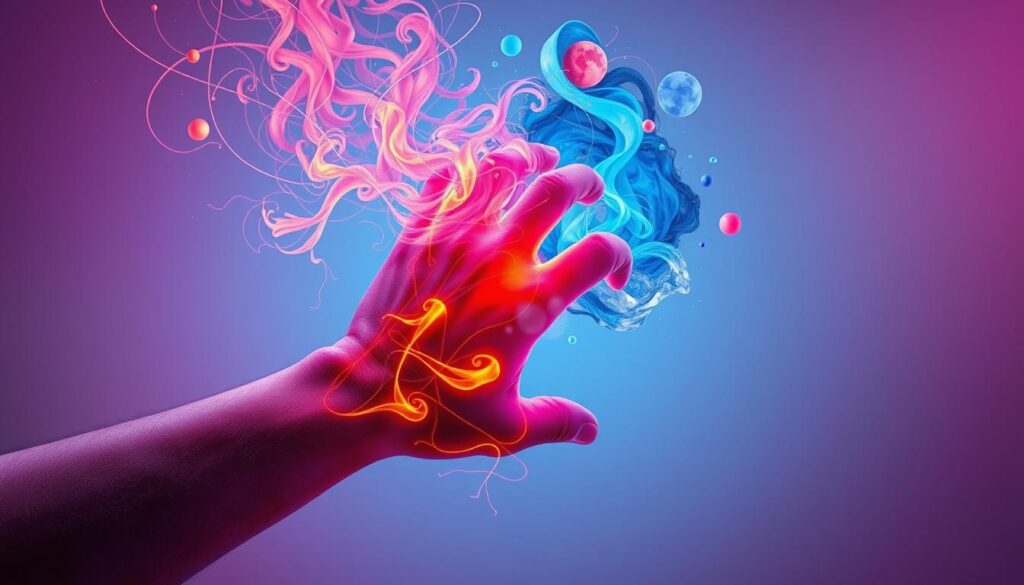Complex Regional Pain Syndrome (CRPS) is a puzzling chronic pain condition. It affects a single limb after an injury, causing extreme pain. This disorder impacts your body’s autonomic nervous system in unexpected ways1.
CRPS often starts after a fracture, surgery, or minor sprain. The pain can be intense and out of proportion to the initial injury1. Surprisingly, this condition can develop without a clear cause and may be triggered by emotional stress1.
CRPS is a complex condition that progresses through specific stages. Each stage brings different challenges for those affected1. Professional medical support is crucial for managing this condition effectively.
Key Takeaways
- CRPS is a complex chronic pain condition affecting limbs
- Pain can be more severe than the initial injury suggests
- Emotional stress can trigger or worsen symptoms
- Early diagnosis and treatment are crucial
- Multiple treatment options exist to manage symptoms
Understanding Complex Regional Pain Syndrome
Complex Regional Pain Syndrome (CRPS) is a tricky neurological condition. It causes intense pain and sensory changes. CRPS can greatly affect your daily life2.
Types of CRPS: A Closer Look
CRPS has two main types. Each type has its own features.
- CRPS-1 (Reflex Sympathetic Dystrophy): Happens without direct nerve damage, making up about 90% of cases3
- CRPS-2 (Causalgia): Develops after a specific nerve injury3
Common Causes and Risk Factors
Several factors can increase your chances of getting CRPS:
- Gender: Women are three times more likely to get CRPS4
- Age: Most common between 40-60 years old4
- Trauma triggers: About 1 in 3 cases come from physical injury4
| Risk Factors | Impact on CRPS Development |
|---|---|
| Severe trauma | High risk of triggering condition |
| Lower limb injuries | Increased susceptibility |
| Smoking | Interferes with nerve regeneration4 |
| Diabetes | Complicates recovery process |
Early Warning Signs and Symptoms
Spotting CRPS early can help with treatment. Look out for these key symptoms:
- Allodynia: Extreme sensitivity to touch
- Hyperalgesia: Intensified pain response
- Skin temperature and color changes
- Unexpected or continuous burning sensations
“Understanding CRPS is the first step towards effective management and potential recovery.”
CRPS can be tough to deal with. However, early treatment can greatly improve your chances of recovery2.
Living with CRPS: Diagnosis and Treatment Options
Complex Regional Pain Syndrome (CRPS) is tough, but knowing your options helps. CRPS diagnosis needs expert medical professionals5. Understanding this condition is key to managing it effectively.
The Budapest criteria are vital for CRPS diagnosis. They check for specific signs and symptoms. These include sensory changes and vasomotor issues.
They also look at motor function alterations. Trophic changes in the affected area are considered too5.
- Sensory changes
- Vasomotor issues
- Motor function alterations
- Trophic changes in the affected area5
CRPS treatment often uses multiple approaches. Rehabilitation is crucial for improving function and managing pain6. Here are some potential strategies:
- Physical therapy to restore movement and reduce pain
- Medication management with various drug classes
- Psychological support to address chronic pain challenges6
CRPS treatment includes various medication options. These aim to manage different aspects of the condition.
- Non-steroidal anti-inflammatory drugs (NSAIDs)
- Antidepressants to modulate neurotransmitters
- Anticonvulsants for pain management
- Corticosteroids to reduce inflammation5
Early intervention is crucial in managing CRPS and preventing condition progression6.
New treatments for CRPS are emerging. Ketamine infusion therapy and neuromodulation show promise. These innovative approaches offer hope for better CRPS management5.
Conclusion
Complex Regional Pain Syndrome (CRPS) demands ongoing research and dedicated pain management strategies. Your CRPS journey can be tough, but new medical insights offer hope. Women are four times more likely to experience CRPS than men7.
Early detection and comprehensive treatment are key in managing CRPS. The average age of onset is 46 years. Knowing your risk factors helps navigate potential challenges8.
Three-phase bone scans and autonomic testing are highly effective diagnostic tools. They boast 85% and 80% accuracy respectively8.
Staying informed about CRPS is crucial for better patient outcomes. Keep up with the latest medical research to develop personalized treatment plans. Each CRPS case is unique78.
A multidisciplinary approach offers the most promising path forward. This includes physical therapy, psychological support, and targeted medications. Work closely with healthcare professionals for the best results78.
FAQ
What is Complex Regional Pain Syndrome (CRPS)?
Are there different types of CRPS?
What are the primary risk factors for developing CRPS?
What are the early warning signs of CRPS?
How is CRPS diagnosed?
What treatment options are available for CRPS?
What is the prognosis for CRPS?
Can CRPS be cured?
How does CRPS affect daily life?
Is CRPS a progressive condition?
Source Links
- Complex Regional Pain Syndrome (CRPS) – https://med.stanford.edu/pain/about/chronic-pain/crps.html
- Complex Regional Pain Syndrome – https://www.ninds.nih.gov/health-information/disorders/complex-regional-pain-syndrome
- Complex regional pain syndrome-Complex regional pain syndrome – Symptoms & causes – Mayo Clinic – https://www.mayoclinic.org/diseases-conditions/crps-complex-regional-pain-syndrome/symptoms-causes/syc-20371151
- Complex Regional Pain Syndrome (CRPS): Causes & Symptoms – https://my.clevelandclinic.org/health/diseases/12085-complex-regional-pain-syndrome-crps
- The complex regional pain syndrome: Diagnosis and management strategies – https://pmc.ncbi.nlm.nih.gov/articles/PMC10827038/
- Living with CRPS: Understanding the Causes, Symptoms & Treatment Options – Pro Spine & Pain – Wisconsin Pain Physicians – https://prospinepain.com/living-with-crps-understanding-the-causes-symptoms-treatment-options/
- Complex Regional Pain Syndrome: An update – https://pmc.ncbi.nlm.nih.gov/articles/PMC7045919/
- Complex Regional Pain Syndrome – StatPearls – https://www.ncbi.nlm.nih.gov/books/NBK430719/
